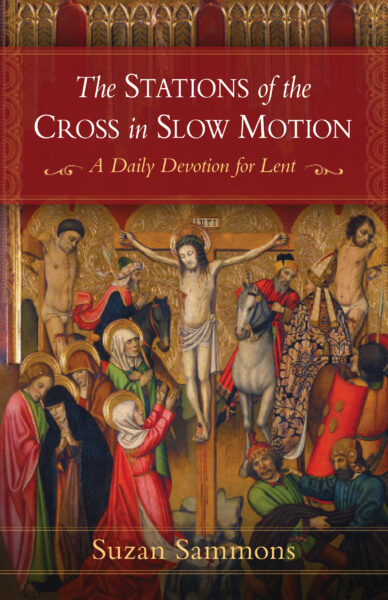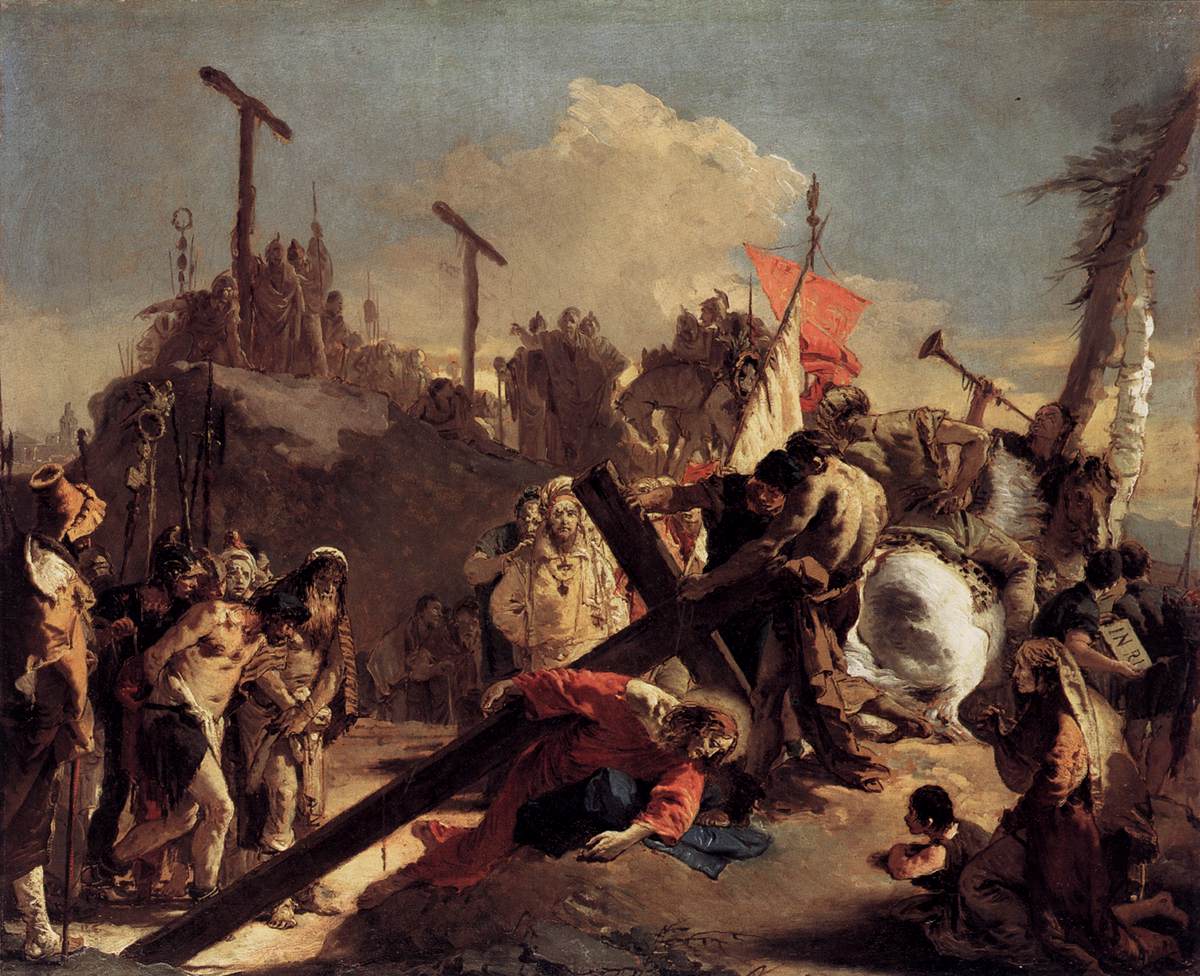|
Getting your Trinity Audio player ready...
|
To guide my Lenten reflections this year, I am using the new book The Stations of the Cross in Slow Motion: A Daily Devotion by Suzan Sammons (Sophia Institute Press, 2023). This book guides the user each day through one Station of the Cross, considering several aspects of each for three to four days at a time, except for one day each for Holy Saturday and the triumph of the Resurrection. It includes forty-seven chapters, one for each day—forty days of Lent plus seven Sundays—, moving through the Stations of the Cross at a slow pace—“in Slow Motion” as the title says (perhaps with a nod to the great “in Slow Motion” works by the late Fr. Ronald Knox?).

In the Introduction, Sammons recognizes that this is a somewhat unusual method of going through the Stations of the Cross, which are traditionally prayed together as a set. Her “Slow Motion” approach is designed to support, by no means replace, the tradition of praying through the Stations all together. In fact, she credits part of her devotion to the Stations of the Cross to her experience as a child with her parish’s practice of this devotion on Fridays during Lent.
This Lenten book is more than just a collection of reflections. Instead, for each day it includes several different types of texts. Each chapter has the following structure:
- One aspect of one Station of the Cross as a focal point.
- The antiphon of the Stations of the Cross in Latin and English, repeated each day.
- A short prayer from one of four saints who accompany the reader throughout the book.
- A short passage from the Bible, using the excellent RSVCE translation.
- A reflection by Sammons.
- A short closing prayer by one of the four saints featured in the book.
- The Gloria Patri… in Latin and English.
- Two questions posed by Sammons for further reflection
This list may sound like a lot of information, but it is not; Sammons has wisely kept each chapter concise. For each day, there are only two or maximum two and half pages of text. This helps, among other things, to make it suitable for daily family Lenten devotions.
As I write this review, it is Ash Wednesday. I put this book to use this morning for the first time. On this day, it helped me consider the condemnation of Jesus at the first Station. I like the way the reflections Sammons has written for each day connect the larger principles of the theme for the day with the individual(s) using the book. For example, her meditation for the first day of Lent helped orient me and encourage me to remain firm in my commitments for the Lenten period until Easter. Also, this book helped me to enter into Lent without feeling overwhelmed by what I had taken on. Yes, our Lenten practices are supposed to challenge us, but taking on a task too huge can foster more discouragement than spiritual growth. This book guides the user at a steady, slow pace, one step at a time, one day at a time, along the path to Easter.
In this spirit, Sammons offers this helpful advice, “If you miss a day, just pick up on the proper day instead of working through several days’ devotions in one sitting. It is better to stick with one chapter each day than to hurry through several.” Sammons is realistic. Yes, we all intend to keep up with our Lenten commitments each day until Easter, yet, meanwhile back in reality, moments of imperfection are part of being human and also, life’s curveballs come flying at us. This books is not about helping Catholics compete in some sort of Lenten Olympics, in which the gold medal goes to the person who can tally up the most laps around the Lenten track. In other words, one thoughtful, focused lap around the track, guided by Sammon’s book, is better than trying to squeeze in five laps at once to play catch up. (In this spirit, it is not too late to get The Stations of the Cross in Slow Motion for Lent this year.)
This book is not about trying to help you accomplish more in less time to race to the finish. Sammons’ book is one for the tortoise, not the hare. For me, it feels like the slow pace I find helpful when, instead of driving to Mass, I ride my bicycle, a favorite practice of mine for spiritual reflection: opting for slower transportation to Mass helps me to mull, in an unhurried manner, over specific aspects such as the reason I am making this trip or perhaps the Introit for the day, a reading, the homily, or some other aspect of that day’s Mass. With Sammons’s book as my guide this Lent, I will travel at a similarly calm pace with Jesus and His companions—His blessed Mother, Veronica, etc.—through the Stations of the Cross, pausing to spend a few days at each one. This slow pace will be a welcome contrast to the “Zoom!” often characteristic of life in the age of automobiles and the Internet. Speaking of which, I recommend getting the print edition of this book; it lends itself to unplugged, distraction-free periods of time. Also, in the print edition, it will be easier than in the Kindle edition to start by viewing the painting of the Station that accompanies this guide for that day.
After all, the Stations of the Cross are traditionally visual representations. With this in mind, at the beginning of each of the fourteen Stations, Sammons’s book features color reproductions for each of the Stations of the Cross by the Belgian painter Théophile Lybaert. For those who want to include a visio divina, a reflection on a sacred image as part of one’s use of this book without flipping pages back and forth, one could print out Lybaert’s Stations, bring the small book along to a church or other location with an artistic representation of the stations, set up representations of the Stations at home (for example, vendors at Etsy offer many options), or even buy a second copy of the book to have it open to the color reproductions of these paintings while reading the accompanying text for the day.
The level of the passages in this book is suitable for children of school age as well as adults, and especially if combined with visual representations, for younger children as well. Sammons designed this book for use by families. And I imagine it would lend itself, for example, to having different family members take turns reading one section of each day’s texts. In addition, this book is suitable for singles (that’s how I will be using it). The two questions for reflection in each chapter, for example, could be used for discussion in families, to mull over individually, or, as Sammons suggests, as a sort of “homework” assignment for children.
At a time when many are discovering the patrimony of the Latin rite anew in our era and Latin is, after all, the language of the Roman rite of the Church, Sammons helpfully offers an opportunity to get to know—and maybe even memorize—bite-sized Latin texts this Lent. The book repeats the same antiphon and the Gloria Patri …, with the text in Latin as well as English each day. In addition, at the back of the book, Sammons has included the verses of the Stabat Mater in Latin and English. There could be many ways to incorporate the Stabat Mater into the use of this book. For my use of the book this Lent, I am reading one verse of the Stabat Mater, and praying along with it, in Latin each day.
If there is a second edition of this book someday, I would like to see Sammons include a source guide as an appendix. While I am sympathetic to the fact that she has written this book to aid in prayer for a general audience, not as an academic study, the only information about the sources of the prayers and inspiration for her reflections, mostly saints and Church Fathers, is that she has mentioned their names in parentheses. However, in her reflections it is sometimes unclear which ideas are from her and which are from these sources. On top of this, the rich content of this guide might inspire some users to delve deeper. Helping readers find their way into the works of the Saints and Church Fathers is always of value. A second edition could include a very compact, shorthand form of source references for those who would like to respond to the prompts of this book with further exploration.
The Stations of the Cross in Slow Motion is a Lenten guide I recommend both to seasoned Catholics as well as those who may be new or newly returning to Lent. This book would be a nice gift for those preparing for confirmation at Easter and for lapsed Catholics who may be considering putting a toe back into the waters of their baptism during Lent. Her previous book, an Advent guide to the Jesse Tree, co-authored with her husband Eric, has been popular and I expect this one will be too.


